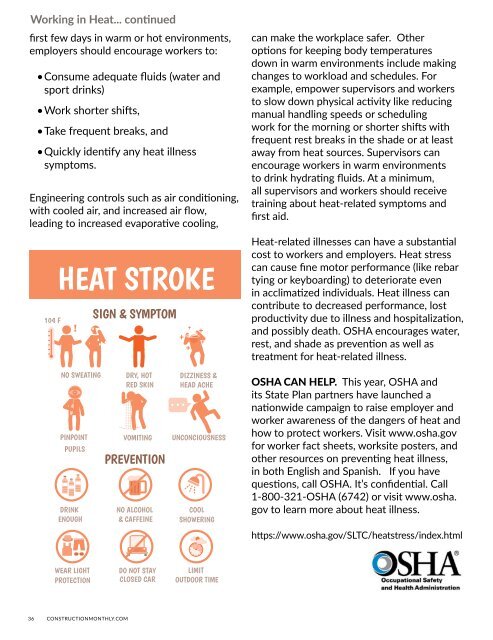Dallas 2020 Construction Monthly
You also want an ePaper? Increase the reach of your titles
YUMPU automatically turns print PDFs into web optimized ePapers that Google loves.
Working in Heat... continued<br />
first few days in warm or hot environments,<br />
employers should encourage workers to:<br />
• Consume adequate fluids (water and<br />
sport drinks)<br />
• Work shorter shifts,<br />
• Take frequent breaks, and<br />
• Quickly identify any heat illness<br />
symptoms.<br />
Engineering controls such as air conditioning,<br />
with cooled air, and increased air flow,<br />
leading to increased evaporative cooling,<br />
can make the workplace safer. Other<br />
options for keeping body temperatures<br />
down in warm environments include making<br />
changes to workload and schedules. For<br />
example, empower supervisors and workers<br />
to slow down physical activity like reducing<br />
manual handling speeds or scheduling<br />
work for the morning or shorter shifts with<br />
frequent rest breaks in the shade or at least<br />
away from heat sources. Supervisors can<br />
encourage workers in warm environments<br />
to drink hydrating fluids. At a minimum,<br />
all supervisors and workers should receive<br />
training about heat-related symptoms and<br />
first aid.<br />
Heat-related illnesses can have a substantial<br />
cost to workers and employers. Heat stress<br />
can cause fine motor performance (like rebar<br />
tying or keyboarding) to deteriorate even<br />
in acclimatized individuals. Heat illness can<br />
contribute to decreased performance, lost<br />
productivity due to illness and hospitalization,<br />
and possibly death. OSHA encourages water,<br />
rest, and shade as prevention as well as<br />
treatment for heat-related illness.<br />
OSHA CAN HELP. This year, OSHA and<br />
its State Plan partners have launched a<br />
nationwide campaign to raise employer and<br />
worker awareness of the dangers of heat and<br />
how to protect workers. Visit www.osha.gov<br />
for worker fact sheets, worksite posters, and<br />
other resources on preventing heat illness,<br />
in both English and Spanish. If you have<br />
questions, call OSHA. It’s confidential. Call<br />
1-800-321-OSHA (6742) or visit www.osha.<br />
gov to learn more about heat illness.<br />
https://www.osha.gov/SLTC/heatstress/index.html<br />
36 CONSTRUCTIONMONTHLY.COM

















